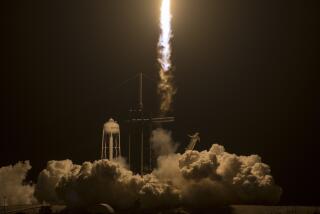Shuttle Launches Lab; It’s Short of Proper Orbit : Space: All experiments could still be successfully carried out, experts say. The danger is that the path may deteriorate, making retrieval too risky.
- Share via
KENNEDY SPACE CENTER, Fla. — U.S. astronauts completed delivery of the European Space Agency’s EURECA laboratory 230 miles above the Earth on Sunday, but the new satellite failed to reach a higher orbit where it is supposed to operate for several months.
European Space Agency officials expressed confidence that a maneuver could be carried out as early as this morning to boost the vehicle into its planned orbit at an altitude of about 330 miles.
If the satellite remains in the low orbit--no more than 10 miles higher than the shuttle itself--it could still conduct the 15 planned experiments. But its orbit could deteriorate over time, potentially to an altitude at which it would be unsafe for a shuttle to recover it, as planned.
It was the second setback in as many days for EURECA; on Saturday, balky communications forced a 24-hour delay in its release. The problems were thought to be unrelated.
Sunday’s troubles came four minutes into a planned 24-minute thruster firing to put the lab into its planned orbit. The European flight control center in Darmstadt, Germany, abruptly stopped the maneuver because its instruments showed that the lab was in the wrong position. The thruster cutoff left it in the low, 230-mile by 240-mile elliptical orbit.
Until the cutoff, the operation had appeared normal to astronauts watching from the shuttle. Whether there was a problem aboard the satellite or merely a faulty indication on the ground was not clear.
But EURECA operations manager Eckart Graf said the problem will be resolved. “We consider it as a glitch in the procedure, as a delay. It’s a very unfortunate one,” he told reporters at the shuttle mission control center in Houston. “However, we are optimistic and very confident that we will have a solution at hand very soon.”
Graf said that the 15 scientific experiments aboard the craft--including brine shrimp eggs, bacteria and fungi spores, seeds, a crystal-growing furnace, a telescope, solar monitors and a cosmic dust catcher--could be successfully carried out. The danger is that the orbit might deteriorate.
Another shuttle is to recover the EURECA, probably in late April, and return it to Earth to be refurbished and loaded with new experiments for another mission. The European Space Agency paid $29 million to NASA for delivery and pickup; the entire EURECA project cost $428 million.
For more than five hours after the shuttle released the satellite--but before the thrusters were fired--Atlantis flew in formation with it to help the European control center check it out before it was boosted into its new orbit. If serious trouble had developed during that time, the satellite could have been hauled back into the cargo bay and returned to Earth.
But once its thrusters fired and moved it away from the shuttle, there was no plan to recover it--because the shuttle did not carry enough fuel and the astronauts had not trained for a rendezvous and rescue mission. In addition, the satellite was moving away from the shuttle at a rate of about 40 miles during every revolution of the Earth, and by afternoon the two were hundreds of miles apart.
Sunday’s delayed release of the EURECA laboratory took place shortly after Atlantis crossed the northeastern coast of New Zealand.
Television pictures later sent down from orbit showed a hauntingly beautiful panorama as the laboratory, with extended solar panels giving it the appearance of a giant moth, moved into a black sky beneath a crescent moon.
Their EURECA responsibilities discharged, the seven-member shuttle crew, commanded by Air Force Col. Loren J. Shriver, turned to their preparations to run an electrical experiment by flying with a satellite tethered to the shuttle on a 12.5-mile-long cord.
With the satellite at the end of the long, electrically conducting tether, the linked vehicles cutting across Earth’s magnetic field lines will become an electrical generator. During the 10 hours that the tether is scheduled to be extended its maximum distance, the system is expected to develop an electrical potential of 5,000 volts with a maximum current of 1 ampere.
Beginning just before 3 a.m. PDT today, the Atlantis crew was to move down into a circular orbit at an altitude of 160 miles, 70 miles beneath the orbit they have traveled since their launch on Friday. The rest of the day will be devoted to activities conducted with the satellite and its tether system still in the shuttle’s cargo bay.
The five-foot-diameter globe is to be released on its tether for 30 hours of operations on Tuesday morning.
The 24-hour delay in releasing EURECA gave the mission specialists aboard the shuttle a head start on some of their preparations for the Tethered-Satellite experiments. But flight controllers in Houston delayed until today or Tuesday a decision on whether to extend the planned seven-day flight for an additional day.
Under the plan being followed before the EURECA deployment delay, Atlantis is to land at the Kennedy Space Center just after 5 a.m. PDT Friday.
The principal reason for an extended mission would be to enable astronauts to complete several experiments planned after the Tethered Satellite is either reeled back into the cargo bay or cut loose. To finish those, the shuttle would be dropped into a still lower orbit and would spend its last day in space flying nose down with its open cargo bay facing forward to expose experiments designed to determine the effects of atoms of oxygen in the ionosphere on various materials.
Although the shuttle has sufficient fuel to fly for an extra day, flight controllers say that “margins are close.”
More to Read
Sign up for Essential California
The most important California stories and recommendations in your inbox every morning.
You may occasionally receive promotional content from the Los Angeles Times.













